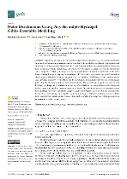Water Desalination Using Polyelectrolyte Hydrogel: Gibbs Ensemble Modeling

Datum vydání
2022Publikováno v
GelsRočník / Číslo vydání
8 (10)ISBN / ISSN
ISSN: 2310-2861Metadata
Zobrazit celý záznamKolekce
Tato publikace má vydavatelskou verzi s DOI 10.3390/gels8100656
Abstrakt
Polyelectrolyte hydrogels can absorb a large amount of water across an osmotic membrane as a result of their swelling pressure. On the other hand, the insoluble cross-linked hydrogel network enables dewatering under the influence of external (thermal and/or mechanical) stimuli. Moreover, from a thermodynamic perspective, a polyelectrolyte hydrogel is already an osmotic membrane. These properties designate hydrogels as excellent candidates for use in desalination, at the same time avoiding the use of expensive membranes. In this article, we present our recent theoretical study of polyelectrolyte hydrogel usage for water desalination. Employing a coarse-grained model and the Gibbs ensemble, we modeled the thermodynamic equilibrium between the coexisting gel phase and the supernate aqueous salt solution phase. We performed a sequence of step-by-step hydrogel swellings and compressions in open and closed systems, i.e., in equilibrium with a large and with a comparably small reservoir of aqueous solution. The swelling in an open system removes ions from the large reservoir, whereas the compression in a closed system decreases the salt concentration in the small reservoir. We modeled this stepwise process of continuous decrease of water salinity from seawater up to freshwater concentrations and estimated the energy cost of the process to be comparable to that of reverse osmosis.
Klíčová slova
polyelectrolye hydrogel, simulation, desalination
Trvalý odkaz
https://hdl.handle.net/20.500.14178/1814Licence
Licence pro užití plného textu výsledku: Creative Commons Uveďte původ 4.0 International







